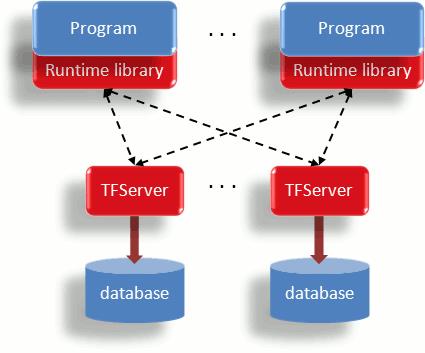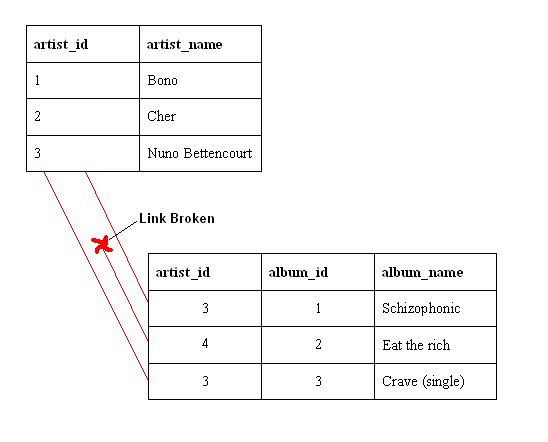|
Raima Database Manager
Raima Database Manager (or RDM) is an ACID-compliant embedded database management system designed for use in embedded systems applications. RDM has been designed to utilize multi-core computers, networking (local or wide area), and on-disk or in-memory storage management. RDM provides support for multiple application programming interfaces (APIs): low-level C API, C++, and SQL(native, ODBC, JDBC, ADO.NET, and REST). RDM is highly portable and is available on Windows, Linux, Unix and several real-time or embedded operating systems. A source-code license is also available. RDM has support for both non-SQL (record and cursor level database access) and SQL database design and manipulation capabilities. The non-SQL features are important for the most resource-restricted embedded system environments, where high performance in a very small footprint is the priority. SQL is important in providing a widely known standard database access method in a small enough footprint for most embedde ... [...More Info...] [...Related Items...] OR: [Wikipedia] [Google] [Baidu] |
Raima
Raima is a multinational technology company headquartered in Seattle, USA. The company was founded in 1982. Raima develops, sells and supports in-memory and disk-based Relational Database Management Systems that can either be embedded within the application or be in a client/server mode. The company's focus is on OLTP databases with high-intensity transactional processing. Their cross-platform, small-footprint products are made to collect, store, manage and move data. History Raima was founded in Seattle, Washington USA in 1982 by two software engineering researchers from Boeing, Randy Merilatt and Wayne Warren, who saw the benefits that database management technology could provide for software application developers in the rapidly growing microcomputer industry. In 1984 Raima released one of the first embedded database management systems for microcomputer applications written in the C programming language. Early contracts with companies like ROLM (now part of IBM), Texas Instru ... [...More Info...] [...Related Items...] OR: [Wikipedia] [Google] [Baidu] |
National Instruments
National Instruments Corporation, doing business as NI, is an American multinational company with international operation. Headquartered in Austin, Texas, it is a producer of automated test equipment and virtual instrumentation software. Common applications include data acquisition, instrument control and machine vision. In 2016, the company sold products to more than 35,000 companies with revenues of US$1.23 billion. History Founding In the early 1970s, James Truchard, Jeff Kodosky, and Bill Nowlin were working at the University of Texas at Austin Applied Research Laboratories. As part of a project conducting research for the U.S. Navy, the men were using early computer technology to collect and analyze data. Frustrated with the inefficient data collection methods they were using, the three decided to create a product that would enable their task to be done more easily. In 1976, working in the garage at Truchard's home, the three founded a new company. They att ... [...More Info...] [...Related Items...] OR: [Wikipedia] [Google] [Baidu] |
Microsoft Windows
Windows is a group of several Proprietary software, proprietary graphical user interface, graphical operating system families developed and marketed by Microsoft. Each family caters to a certain sector of the computing industry. For example, Windows NT for consumers, Windows Server for servers, and Windows IoT for embedded systems. Defunct Windows families include Windows 9x, Windows Mobile, and Windows Phone. The first version of Windows was released on November 20, 1985, as a graphical operating system shell for MS-DOS in response to the growing interest in graphical user interfaces (GUIs). Windows is the most popular desktop operating system in the world, with Usage share of operating systems, 75% market share , according to StatCounter. However, Windows is not the most used operating system when including both mobile and desktop OSes, due to Android (operating system), Android's massive growth. , the most recent version of Windows is Windows 11 for consumer Personal compu ... [...More Info...] [...Related Items...] OR: [Wikipedia] [Google] [Baidu] |
Database Replication
Replication in computing involves sharing information so as to ensure consistency between redundant resources, such as software or hardware components, to improve reliability, fault-tolerance, or accessibility. Terminology Replication in computing can refer to: * ''Data replication'', where the same data is stored on multiple storage devices * ''Computation replication'', where the same computing task is executed many times. Computational tasks may be: ** ''Replicated in space'', where tasks are executed on separate devices ** ''Replicated in time'', where tasks are executed repeatedly on a single device Replication in space or in time is often linked to scheduling algorithms. Access to a replicated entity is typically uniform with access to a single non-replicated entity. The replication itself should be transparent to an external user. In a failure scenario, a failover of replicas should be hidden as much as possible with respect to quality of service. Computer scienti ... [...More Info...] [...Related Items...] OR: [Wikipedia] [Google] [Baidu] |
High Availability
High availability (HA) is a characteristic of a system which aims to ensure an agreed level of operational performance, usually uptime, for a higher than normal period. Modernization has resulted in an increased reliance on these systems. For example, hospitals and data centers require high availability of their systems to perform routine daily activities. Availability refers to the ability of the user community to obtain a service or good, access the system, whether to submit new work, update or alter existing work, or collect the results of previous work. If a user cannot access the system, it is – from the user's point of view – ''unavailable''. Generally, the term '' downtime'' is used to refer to periods when a system is unavailable. Principles There are three principles of systems design in reliability engineering which can help achieve high availability. # Elimination of single points of failure. This means adding or building redundancy into the system so tha ... [...More Info...] [...Related Items...] OR: [Wikipedia] [Google] [Baidu] |
Advanced Encryption Standard
The Advanced Encryption Standard (AES), also known by its original name Rijndael (), is a specification for the encryption of electronic data established by the U.S. National Institute of Standards and Technology (NIST) in 2001. AES is a variant of the Rijndael block cipher developed by two Belgian cryptographers, Joan Daemen and Vincent Rijmen, who submitted a proposal to NIST during the AES selection process. Rijndael is a family of ciphers with different key and block sizes. For AES, NIST selected three members of the Rijndael family, each with a block size of 128 bits, but three different key lengths: 128, 192 and 256 bits. AES has been adopted by the U.S. government. It supersedes the Data Encryption Standard (DES), which was published in 1977. The algorithm described by AES is a symmetric-key algorithm, meaning the same key is used for both encrypting and decrypting the data. In the United States, AES was announced by the NIST as U.S. FIPS PUB 197 (FIPS 197) on Novemb ... [...More Info...] [...Related Items...] OR: [Wikipedia] [Google] [Baidu] |
Referential Integrity
Referential integrity is a property of data stating that all its references are valid. In the context of relational databases, it requires that if a value of one attribute (column) of a relation (table) references a value of another attribute (either in the same or a different relation), then the referenced value must exist. For referential integrity to hold in a relational database, any column in a base table that is declared a foreign key can only contain either null values or values from a parent table's primary key or a candidate key. In other words, when a foreign key value is used it must reference a valid, existing primary key in the parent table. For instance, deleting a record that contains a value referred to by a foreign key in another table would break referential integrity. Some relational database management systems (RDBMS) can enforce referential integrity, normally either by deleting the foreign key rows as well to maintain integrity, or by returning an error and ... [...More Info...] [...Related Items...] OR: [Wikipedia] [Google] [Baidu] |
B-tree
In computer science, a B-tree is a self-balancing tree data structure that maintains sorted data and allows searches, sequential access, insertions, and deletions in logarithmic time. The B-tree generalizes the binary search tree, allowing for nodes with more than two children. Unlike other self-balancing binary search trees, the B-tree is well suited for storage systems that read and write relatively large blocks of data, such as databases and file systems. Origin B-trees were invented by Rudolf Bayer and Edward M. McCreight while working at Boeing Research Labs, for the purpose of efficiently managing index pages for large random-access files. The basic assumption was that indices would be so voluminous that only small chunks of the tree could fit in main memory. Bayer and McCreight's paper, ''Organization and maintenance of large ordered indices'', was first circulated in July 1970 and later published in '' Acta Informatica''. Bayer and McCreight never explained what, ... [...More Info...] [...Related Items...] OR: [Wikipedia] [Google] [Baidu] |
Network Model
The network model is a database model conceived as a flexible way of representing objects and their relationships. Its distinguishing feature is that the schema, viewed as a graph in which object types are nodes and relationship types are arcs, is not restricted to being a hierarchy or lattice. The network model was adopted by the CODASYL Data Base Task Group in 1969 and underwent a major update in 1971. It is sometimes known as the CODASYL model for this reason. A number of network database systems became popular on mainframe and minicomputers through the 1970s before being widely replaced by relational databases in the 1980s. Overview While the hierarchical database model structures data as a tree of records, with each record having one parent record and many children, the network model allows each record to have multiple parent and child records, forming a generalized graph structure. This property applies at two levels: the schema is a generalized graph of record types ... [...More Info...] [...Related Items...] OR: [Wikipedia] [Google] [Baidu] |
Hash Table
In computing, a hash table, also known as hash map, is a data structure that implements an associative array or dictionary. It is an abstract data type that maps keys to values. A hash table uses a hash function to compute an ''index'', also called a ''hash code'', into an array of ''buckets'' or ''slots'', from which the desired value can be found. During lookup, the key is hashed and the resulting hash indicates where the corresponding value is stored. Ideally, the hash function will assign each key to a unique bucket, but most hash table designs employ an imperfect hash function, which might cause hash '' collisions'' where the hash function generates the same index for more than one key. Such collisions are typically accommodated in some way. In a well-dimensioned hash table, the average time complexity for each lookup is independent of the number of elements stored in the table. Many hash table designs also allow arbitrary insertions and deletions of key–value pa ... [...More Info...] [...Related Items...] OR: [Wikipedia] [Google] [Baidu] |
R-Tree
R-trees are tree data structures used for spatial access methods, i.e., for indexing multi-dimensional information such as geographical coordinates, rectangles or polygons. The R-tree was proposed by Antonin Guttman in 1984 and has found significant use in both theoretical and applied contexts. A common real-world usage for an R-tree might be to store spatial objects such as restaurant locations or the polygons that typical maps are made of: streets, buildings, outlines of lakes, coastlines, etc. and then find answers quickly to queries such as "Find all museums within 2 km of my current location", "retrieve all road segments within 2 km of my location" (to display them in a navigation system) or "find the nearest gas station" (although not taking roads into account). The R-tree can also accelerate nearest neighbor search for various distance metrics, including great-circle distance. R-tree idea The key idea of the data structure is to group nearby objects and represent ... [...More Info...] [...Related Items...] OR: [Wikipedia] [Google] [Baidu] |


_Round_Function.png)
